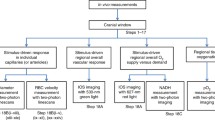Abstract
To better understand cellular interactions of the cerebral angiogenesis induced by hypoxia, a spatiotemporal dynamics of cortical microvascular restructuring during an exposure to continuous hypoxia was characterized with in vivo two-photon microscopy in mouse cortex. The mice were prepared with a closed cranial window over the sensory-motor cortex and housed in 8–9 % oxygen room for 2–4 weeks. Before beginning the hypoxic exposure, two-photon imaging of cortical microvasculature was performed, and the follow-up imaging was conducted weekly in the identical locations. We observed that 1–2 weeks after the onset of hypoxic exposure, a sprouting of new vessels appeared from the existing capillaries. An average emergence rate of the new vessel was 15 vessels per unit volume (mm3). The highest emergence rate was found in the cortical depths of 100–200 μm, indicating no spatial uniformity among the cortical layers. Further, a leakage of fluorescent dye (sulforhodamine 101) injected into the bloodstream was not detected, suggesting that the blood–brain barrier (BBB) was maintained. Future studies are needed to elucidate the roles of perivascular cells (e.g., pericyte, microglia, and astroglia) in a process of this hypoxia-induced angiogenesis, such as sprouting, growth, and merger with the existing capillary networks, while maintaining the BBB.
Access this chapter
Tax calculation will be finalised at checkout
Purchases are for personal use only
Similar content being viewed by others
References
Abbott NJ, Rönnbäck L, Hansson E (2006) Astrocyte-endothelial interactions at the blood–brain barrier. Nat Rev Neurosci 7(1):41–53
Mathiisen TM, Lehre KP, Danbolt NC, Ottersen OP (2010) The perivascular astroglial sheath provides a complete covering of the brain microvessels: an electron microscopic 3D reconstruction. Glia 58(9):1094–1103
Yoshihara K, Takuwa H, Kanno I, Okawa S, Yamada Y, Masamoto K (2013) 3D Analysis of intracortical microvasculature during chronic hypoxia in mouse brains. Adv Exp Med Biol 765:357–363
LaManna JC, Vendel LM, Farrell RM (1992) Brain adaptation to chronic hypobaric hypoxia in rats. J Appl Physiol 72(6):2238–2243
Xu K, Lamanna JC (2006) Chronic hypoxia and the cerebral circulation. J Appl Physiol 100(2):725–730
Benderro GF, Lamanna JC (2011) Hypoxia-induced angiogenesis is delayed in aging mouse brain. Brain Res 1389:50–60
Tomita Y, Kubis N, Calando Y et al (2005) Long-term in vivo investigation of mouse cerebral microcirculation by fluorescence confocal microscopy in the area of focal ischemia. J Cereb Blood Flow Metab 25(7):858–867
Masamoto K, Tomita Y, Toriumi H et al (2012) Repeated longitudinal in vivo imaging of neuro-glio-vascular unit at the peripheral boundary of ischemia in mouse cerebral cortex. Neuroscience 212:190–200
Lin CS, Polsky K, Nadler JV, Crain BJ (1990) Selective neocortical and thalamic cell death in the gerbil after transient ischemia. Neuroscience 35(2):289–299
Acknowledgments
The authors thank Mr. Kouichi Yoshihara, Ryota Sakamoto, and Ryutaro Asaga for their help with the experiments. A part of this work was supported by Special Coordination Funds for Promoting Science and Technology, Japan (K.M.).
Author information
Authors and Affiliations
Corresponding author
Editor information
Editors and Affiliations
Rights and permissions
Copyright information
© 2013 Springer Science+Business Media New York
About this paper
Cite this paper
Masamoto, K. et al. (2013). Hypoxia-Induced Cerebral Angiogenesis in Mouse Cortex with Two-Photon Microscopy. In: Van Huffel, S., Naulaers, G., Caicedo, A., Bruley, D.F., Harrison, D.K. (eds) Oxygen Transport to Tissue XXXV. Advances in Experimental Medicine and Biology, vol 789. Springer, New York, NY. https://doi.org/10.1007/978-1-4614-7411-1_3
Download citation
DOI: https://doi.org/10.1007/978-1-4614-7411-1_3
Published:
Publisher Name: Springer, New York, NY
Print ISBN: 978-1-4614-7256-8
Online ISBN: 978-1-4614-7411-1
eBook Packages: Biomedical and Life SciencesBiomedical and Life Sciences (R0)




